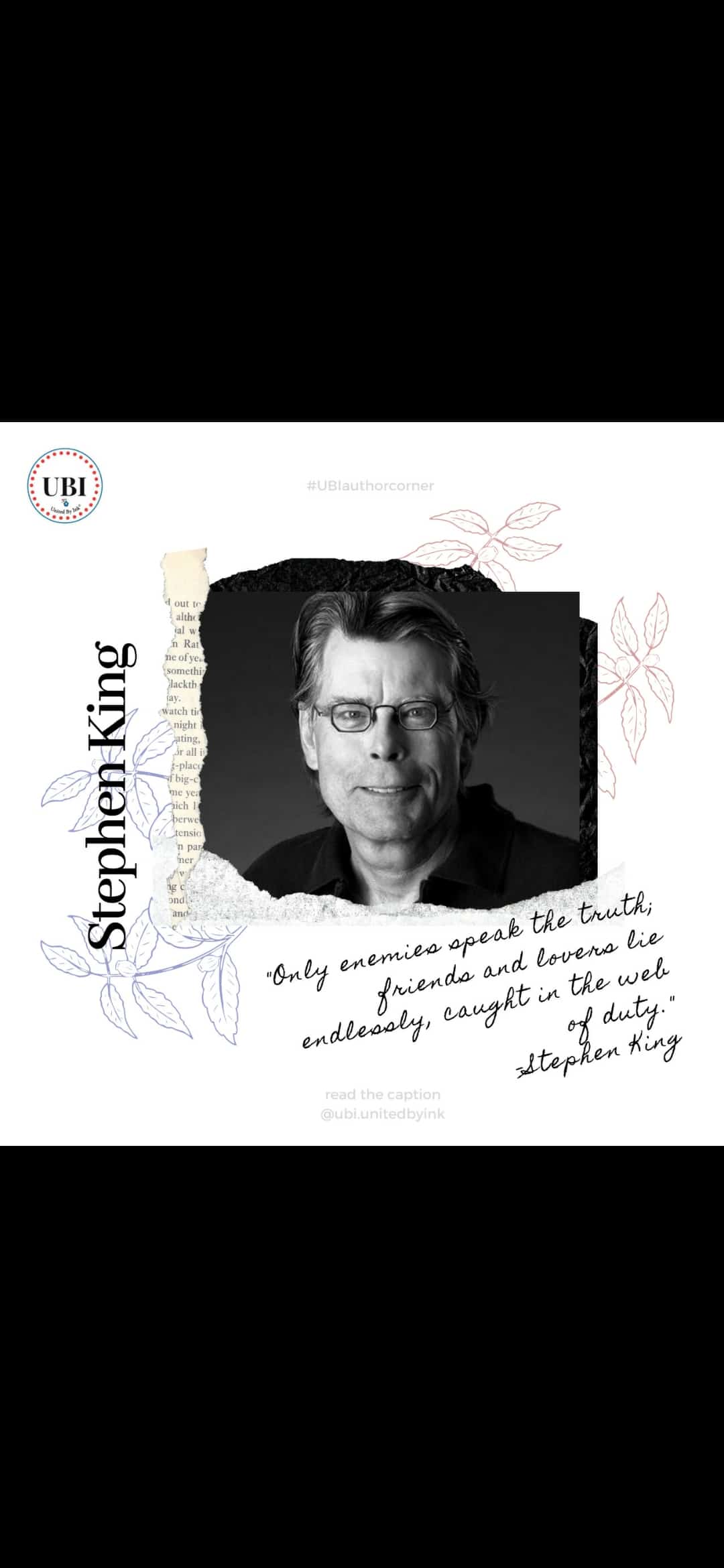
Stephen King, in full Stephen Edwin King, (born September 21, 1947, Portland, Maine, U.S.), American novelist and short-story writer whose books were credited with reviving the genre of horror fiction in the late 20th century.
Carrie was the first of many novels in which King blended horror, the macabre, fantasy, and science fiction. Among such works were ’Salem’s Lot (1975; TV miniseries 1979 and 2004); The Shining (1977; film 1980; TV miniseries 1997); The Stand (1978; TV miniseries 1994 and 2020–21); The Dead Zone (1979; film 1983; TV series 2002–07); Firestarter (1980; film 1984); Cujo (1981; film 1983); The Running Man (1982; film 1987); Christine (1983; film 1983); Thinner (1984; film 1996); It (1986; TV miniseries 1990; film 2017 and 2019); Misery (1987; film 1990); The Tommyknockers (1987; TV miniseries 1993); The Dark Half (1989; film 1993); Needful Things (1991; film 1993); Dolores Claiborne (1993; film 1995); Dreamcatcher (2001; film 2003); Cell (2006); Lisey’s Story (2006; TV miniseries 2021); Duma Key (2008); Under the Dome (2009; TV series 2013–15); 11/22/63 (2011; TV miniseries 2016); Joyland (2013); Doctor Sleep (2013; film 2019), a sequel to The Shining; Revival (2014); The Outsider (2018; TV miniseries 2020); The Institute (2019); and Later (2021). King published several of those works, including The Dead Zone and The Running Man, under the pseudonym Richard Bachman. A collection of the first four Bachman novels, The Bachman Books (1985), contains the essay “Why I Was Bachman.” Mr. Mercedes (2014), Finders Keepers (2015), and End of Watch (2016) formed a trilogy of hard-boiled crime novels centring on retired detective Bill Hodges. King also wrote a serial novel, The Dark Tower, whose first installment, The Gunslinger, appeared in 1982; an eighth volume was published in 2012. A film adaptation of the series was released in 2017.
In his books King explored almost every terror-producing theme imaginable, from vampires, rabid dogs, deranged killers, and a pyromaniac to ghosts, extrasensory perception and telekinesis, biological warfare, and even a malevolent automobile. In his later fiction, exemplified by Dolores Claiborne, King departed from the horror genre to provide sharply detailed psychological portraits of his protagonists, many of them women, who confront difficult and challenging circumstances. Though his work was sometimes disparaged as undisciplined and inelegant, King was a talented storyteller whose books gained their effect from realistic detail, forceful plotting, and the author’s undoubted ability to involve and scare the reader. His work consistently addressed such themes as the potential for politics and technology to disrupt or even destroy an individual human life. Obsession, the forms it can assume, and its power to wreck individuals, families, and whole communities was a recurring theme in King’s fiction, driving the narratives of Christine, Misery, and Needful Things.
STEPHEN KING
Home
Literature
Novels & Short Stories
Novelists A-K
Stephen King
American novelist
BY The Editors of Encyclopaedia Britannica Last Updated: Sep 17, 2021 | View Edit History
2-Min Summary
FULL ARTICLE
Stephen King, in full Stephen Edwin King, (born September 21, 1947, Portland, Maine, U.S.), American novelist and short-story writer whose books were credited with reviving the genre of horror fiction in the late 20th century.
Stephen King
Stephen King
See all media
Born: September 21, 1947 (age 74) Portland Maine
Awards And Honors: National Medal of Arts (2015) National Medal of Arts (2015) National Book Award (2003)
Notable Works: “Dolores Claiborne”
King graduated from the University of Maine in 1970 with a bachelor’s degree in English. While writing short stories he supported himself by teaching and working as a janitor, among other jobs. His first published novel, Carrie, about a tormented teenage girl gifted with telekinetic powers, appeared in 1974 (film 1976 and 2013) and was an immediate popular success.
Frankenstein, Boris Karloff (1931). Directed by James Whale
BRITANNICA QUIZ
Monsters, Ghouls, and Ghosts Quiz
How long did it take Anne Rice to write Interview with a Vampire? Which U.S. state seems to be Stephen King’s favourite? Test your knowledge of pop culture’s monsters, ghouls, and ghosts in this quiz.
Carrie was the first of many novels in which King blended horror, the macabre, fantasy, and science fiction. Among such works were ’Salem’s Lot (1975; TV miniseries 1979 and 2004); The Shining (1977; film 1980; TV miniseries 1997); The Stand (1978; TV miniseries 1994 and 2020–21); The Dead Zone (1979; film 1983; TV series 2002–07); Firestarter (1980; film 1984); Cujo (1981; film 1983); The Running Man (1982; film 1987); Christine (1983; film 1983); Thinner (1984; film 1996); It (1986; TV miniseries 1990; film 2017 and 2019); Misery (1987; film 1990); The Tommyknockers (1987; TV miniseries 1993); The Dark Half (1989; film 1993); Needful Things (1991; film 1993); Dolores Claiborne (1993; film 1995); Dreamcatcher (2001; film 2003); Cell (2006); Lisey’s Story (2006; TV miniseries 2021); Duma Key (2008); Under the Dome (2009; TV series 2013–15); 11/22/63 (2011; TV miniseries 2016); Joyland (2013); Doctor Sleep (2013; film 2019), a sequel to The Shining; Revival (2014); The Outsider (2018; TV miniseries 2020); The Institute (2019); and Later (2021). King published several of those works, including The Dead Zone and The Running Man, under the pseudonym Richard Bachman. A collection of the first four Bachman novels, The Bachman Books (1985), contains the essay “Why I Was Bachman.” Mr. Mercedes (2014), Finders Keepers (2015), and End of Watch (2016) formed a trilogy of hard-boiled crime novels centring on retired detective Bill Hodges. King also wrote a serial novel, The Dark Tower, whose first installment, The Gunslinger, appeared in 1982; an eighth volume was published in 2012. A film adaptation of the series was released in 2017.
Bill Skarsgård as Pennywise in It (2017), a film adaptation of Stephen King’s novel.
In his books King explored almost every terror-producing theme imaginable, from vampires, rabid dogs, deranged killers, and a pyromaniac to ghosts, extrasensory perception and telekinesis, biological warfare, and even a malevolent automobile. In his later fiction, exemplified by Dolores Claiborne, King departed from the horror genre to provide sharply detailed psychological portraits of his protagonists, many of them women, who confront difficult and challenging circumstances. Though his work was sometimes disparaged as undisciplined and inelegant, King was a talented storyteller whose books gained their effect from realistic detail, forceful plotting, and the author’s undoubted ability to involve and scare the reader. His work consistently addressed such themes as the potential for politics and technology to disrupt or even destroy an individual human life. Obsession, the forms it can assume, and its power to wreck individuals, families, and whole communities was a recurring theme in King’s fiction, driving the narratives of Christine, Misery, and Needful Things.
By the early 1990s King’s books had sold more than 100 million copies worldwide, and his name had become synonymous with the genre of horror fiction. His short fiction was collected in such volumes as Night Shift (1978), Nightmares and Dreamscapes (1993), Hearts in Atlantis (1999; film 2001), Just After Sunset (2008), and The Bazaar of Bad Dreams (2015). The story “Rita Hayworth and Shawshank Redemption,” which was published in Different Seasons (1982), inspired the hugely popular film The Shawshank Redemption (1994).
Numerous other adaptations were made of King’s works, both for TV and film, and they involved such notable directors as John Carpenter, David Cronenberg, Brian De Palma, Stanley Kubrick, and Rob Reiner. While King often had little participation in these projects, he wrote the TV miniseries The Shining (1997) and Lisey’s Story (2021). He also penned several motion-picture screenplays. King explored both his own career and the craft of writing in On Writing (2000), a book he completed as he was recovering from severe injuries received after being struck by a car. King experimented with different forms of book distribution: The Plant: Zenith Rising was released in 2000 solely as an e-book, distributed via the Internet, with readers asked but not required to pay for it, and the novella UR was made available in 2009 only to users of the Kindle electronic reading device. The short story “Drunken Fireworks” was released in 2015 as an audiobook prior to its print publication.
King’s family included his wife, Tabitha King, and their two sons, Joe Hill and Owen King, all of whom were novelists. With Owen he wrote Sleeping Beauties (2017), in which women become wrapped in cocoons when they fall asleep. King received the National Book Foundation’s Medal for Distinguished Contribution to American Letters in 2003 and the National Medal of Arts in 2015.
How useful was this post?
Click on a star to rate it!
Average rating 0 / 5. Vote count: 0
No votes so far! Be the first to rate this post.

UBI stands for United By Ink®️. UBI is a Global Platform- the real-time social media interactive forum created for Readers, Writers and Facilitators alike.This platform aims to help creative souls realize their writing goals.
Click on our representatives below to chat on WhatsApp or send us an email to ubi.unitedbyink@gmail.com
